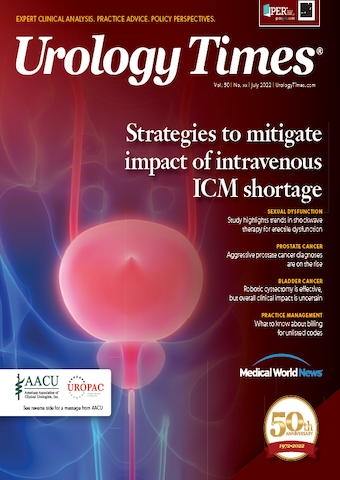Publication
Article
Urology Times Journal
Robotic cystectomy is effective, but overall clinical impact is uncertain
Author(s):
Randomized controlled trial compares intracorporeal robotic technique with open surgery.
Badar M. Mian, MD

Radical cystectomy, along with systemic therapy, remains the recommended standard of care for patients with muscle-invasive bladder cancer. Often, patients requiring this complex surgery are older and have significant comorbidities that predispose a patient to a high rate of perioperative complications. Several interventions have been utilized to improve the outcomes following radical cystectomy. These include subspecialization, regionalization, early recovery protocols, and more recently, use of minimally invasive robotic surgery.
To determine the effect of robotic surgery on perioperative recovery and complications, Catto et al conducted a randomized controlled trial comparing completely intracorporeal robotic cystectomy with open surgery.1 The primary outcome measure was the number of days alive and out of the hospital within 90 days of surgery. Several other secondary outcomes were measured, including complication rate, quality of life, activity levels, and survival.
The investigators randomized 338 patients to either robotic radical cystectomy with intracorporeal reconstruction or open radical cystectomy. Of these, 317 patients underwent radical cystectomy and 305 were analyzed for primary outcome after either robotic radical cystectomy (n = 156) or open surgery (n = 149). Nearly one-third of patients received neoadjuvant chemotherapy and 89% received an ileal conduit. The mean age was 69 years (6% were 80+ years) and 79% were men.
The authors report that the median number of days alive and out of the hospital within 90 days of surgery for patients undergoing robotic cystectomy vs open surgery was 82 days and 80 days (P = .01), respectively. The median length of hospital stay was 7 days for robotic cystectomy and 8 days for open surgery (P = .05). Hospital readmission after discharge was required in 21.8% undergoing robotic cystectomy and 32.2% undergoing open cystectomy (difference, 10.4% [95% CI, 0.5%-20.3%]; P = .04). Cancer recurrence rates and all-cause mortality were similar between the groups.
Two-thirds (65.6%) of the patients had at least 1 complication within 12 weeks, including 63.4% in the robotic surgery group and 67.9% in the open surgery group. The robotic surgery group, compared with open surgery, had significantly less wound-related complications (5.6% vs 17.3%; difference, –11.72%) and thromboembolic complications (1.9% vs 8.3%; difference, –6.47%). Rates of other complications were essentially similar between groups.
General health-related quality of life (HRQOL) at 5 weeks was statistically significantly worse in the open surgery group, but the scores were similar between the groups at 12 weeks. Using a different HRQOL instrument, statistically significantly higher HRQOL was noted in the robotic surgery group at 5 and 12 weeks, but no difference was noted by 26 weeks. Overall, there was no significant difference in the activity level (as measured by daily step count) by week 5 and week 12.
This randomized controlled trial (RCT) has some important and distinct features when compared with previous studies. The current study focused on postoperative recovery, including complications and readmission using a completely intracorporeal technique. A previous RCT comparing robotic surgery (with open diversion) and open surgery had primarily focused on oncological outcomes, declaring the robotic approach as noninferior.2 The current study used an interesting primary end point (ie, number of days alive and out of hospital), which is a composite of postoperative length of stay, any readmissions, and deaths within 90 days. The investigators used 2 days as the minimum detectable difference for robotic surgery, as this difference was viewed by their health care purchasers to be of sufficient benefit to fund robotic surgery service in the British health care system. This difference of 2 days over a 3-month period may be too modest to mitigate the health care cost of robotic surgery in the United States.
Much of the benefit from robotic or other minimally invasive approaches is realized in the early post-operative period as evident from the early convalescence, increased mobility, and improved HRQOL in the first 5 weeks after surgery. However, the differences in HRQOL and activity level disappeared by 3 or 6 months after surgery. Although the overall complication rates were similar, the robotic surgery group had a lower risk of wound and thromboembolic complications, perhaps due to early and increased mobility following robotic cystectomy.
The investigators are to be commended for being able to conduct an RCT of 2 surgical approaches—a task that has been notoriously difficult to complete. This study demonstrated that robotic cystectomy with intracorporeal diversion was statistically superior by 2 days in terms of days alive and out of the hospital. As the authors point out, the clinical importance of these findings across various health systems and patient populations is uncertain.
Other studies have reported that proposed benefits of robotic surgery, such as smaller incisions, improved high-definition vision, decreased blood loss, and increased mobility, may not translate into improved functional recovery, HRQOL, or cancer control. Yet, several high-volume centers continue to promote the use of the robotic approach as the new standard of care. With the relatively modest and variable advantages of robotic cystectomy reported by this and previous RCTs, surgeons should continue to offer their best surgical technique (open or robotic) to patients in need of radical cystectomy.
References
1. Catto JWF, Khetrapal P, Ricciardi F, et al. Effect of robot-assisted radical cystectomy with intracorporeal urinary diversion vs open radical cystectomy on 90-day morbidity and mortality among patients with bladder cancer: a randomized clinical trial. JAMA.2022;327(21):2092-2103. doi:10.1001./jama.2022.7393
2. Parekh DJ, Reis IM, Castle EP, et al. Robot-assisted radical cystectomy versus open radical cystectomy in patients with bladder cancer (RAZOR): an open-label, randomised, phase 3, non-inferiority trial. Lancet. 2018;391(10139):2525-2536. doi:10.1016/S0140-6736(18)30996-6




























